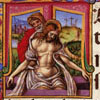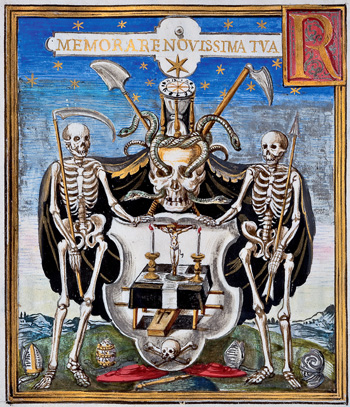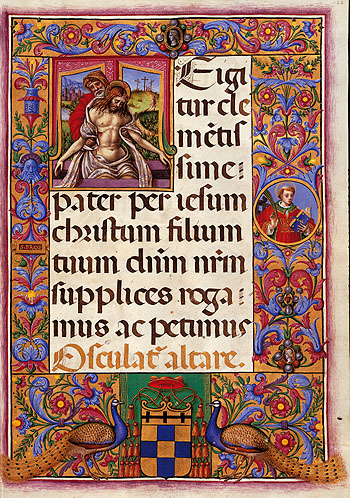Lost Sistine Chapel Manuscripts Exhibited for the First Time in U.S.
Ancient manuscripts from the Sistine Chapel, long thought lost, go on exhibit at Meadows Museum.

DALLAS – The only remaining set of codices from the Sacristy of the Sistine Chapel will be on display at The Lost Manuscripts from the Sistine Chapel: An Epic Journey from Rome to Toledo, an exhibit that opened January 23 at SMU's Meadows Museum and continues through April 23.
Featuring 40 codices that range in date from the 11th to the 18th century, the collection represents some of the finest illuminations ever discovered, and follows the trajectory of an exciting and significant time at the Vatican and Sistine Chapel.
The codices were looted from the Vatican by Napoleon’s armies and then rescued by the dynamic Archbishop of Toledo, Cardinal Francesco Antonio José de Lorenzana y Buitrón, who gave them to the Biblioteca Capitular de Toledo for safekeeping.
For 200 years the codices all but disappeared from history, until the late 1990s when the Italian scholar Dr. Elena DeLaurentiis saw a photograph of the Codices with the Barberini seal and traced their location to the Cathedral in Toledo. Since their discovery scholars have been cataloguing and studying the manuscripts, piecing together one of the most valuable collections of liturgical manuscripts in the world.
“Many of the codices are in perfect condition, and they have provided unprecedented insight into one of the most vibrant historical time periods at the Vatican,” said Meadows Museum Director Mark Roglán. “This is a very exciting discovery, and allows us to reconstruct one of the most important and valued pieces of papal heritage.”
 Votive Missal of Urban VIII, 1635. Toledo, Biblioteca Pública of Estando de Toledo – Biblioteca Capitular de Toledo. |
The opening of The Lost Manuscripts from the Sistine Chapel at the Meadows Museum represents the first time that these ancient manuscripts will be on display in the U.S. Curated by Dr. De Laurentiis and fellow Italian scholar Emilia Anna Talamo, the exhibition will feature abroad range of liturgical writings used by the Catholic Church, including benedictionals, blessings, breviaries, epistolaries, evangelistaries, missals, and preparations for mass.
Though the manuscripts were undiscovered for years, the illustrations remain in pristine condition, and demonstrate some of the best preserved examples of the complex decorative schemes executed and influenced by master illuminators of the papal scriptorium, such as the French illuminator Vincent Raymond and the Italian illuminator Apollonio de’ Bonfratelli.
Notable among the rediscovered manuscripts is the “Missal with Christmas Mass of Cardinal Antoniotto Pallavicini,” which dates to between 1503 and 1509, and is regarded as one of the richest and most exquisite codices from the Sistine Sacristy Collection.
The exhibition, which will first open at the National Library in Madrid on October 20, 2010, is organized through partnerships with the Centro de Estudios Europa Hispánica, the Biblioteca Nacional de España, the Biblioteca de Castilla-La Mancha, the Catedral de Toledo, and the Palacio Arzobispal de Toledo. In conjunction with the exhibition, a catalogue will provide profiles of these codices, as well as scholarly essays by the curators. The catalogue is being prepared by the Centro de Estudios Europa Hispánica and will be published in English, Spanish and Italian.
About International Collaborations
The Meadows has a long history of collaboration with renowned international institutions. Over the course of Director Mark Roglán’s tenure, the Meadows has mounted numerous exhibitions presenting works that rarely travel to the U.S., partnering with major Spanish institutions including the National Archaeological Museum of Spain, Patrimonio Nacional, and the Thyssen-Bornemisza Museum in Madrid.
This year the Meadows launched a three-year partnership with the Prado Museum in Madrid. The two museums have a shared mission to advance the recognition and understanding of Spanish art, and this partnership represents the logical next step in furthering the goals of each museum. The collaboration –the first international program of its kind for the Prado – will include the loan of major paintings from the Prado, interdisciplinary research at SMU, an internship exchange between the two museums, and a range of public programs. The loans from the Prado include El Greco’s monumental masterpiece Pentecost, Jusepe de Ribera’s Mary Magdalene and Diego Velázquez’s full length portrait of Philip IV. Upon the arrival of each loan, the museum will produce a bilingual publication presenting new research across multiple subject areas, and will organize a series of symposia and educational programming with national and international scholars.
Frieze with Cardinalitial Coat of Arms of Cardinal Antoniotto Pallavicini and Initial T (Te igitur) with the Pietá, 1503-07. Folio 66r of the Missal with the Mass of Christmas of Cardinal Antoniotto Pallavicini.In the fall of 2011, the two museums will initiate The Algur H.Meadows/Prado Internships, an annual exchange with one appointment made by each institution. This will be the first curatorial internship ever to be mounted by the Prado with a foreign institution. Sponsored by the Meadows Museum, the internships will provide graduate students with the opportunity to gain professional and international experience, and to work closely with the curatorial staff at each institution.
About The Meadows Museum
The Meadows Museum is the leading U.S. institution focused on the study and presentation of the art of Spain. In 1962, Dallas businessman and philanthropist Algur H. Meadows donated his private collection of Spanish paintings, as well as funds to start a museum, to Southern Methodist University. The museum opened to the public in 1965, marking the first step in fulfilling Meadows’ vision to create a “Prado on the Prairie.” Meadows hired William B. Jordan, an American historian of Spanish painting, in 1967 to serve as director of the Museum, and worked with him over the next 11 years to assemble an outstanding collection of Spanish masterpieces.
Today, the Meadows collection of Spanish art — one of the largest and most comprehensive outside of Spain — comprises more than 125 paintings and sculptures and approximately 450works on paper. The collection spans from the 10th to the 21st century, and includes medieval objects, Renaissance and Baroque sculptures, and major paintings by Golden Age and modern masters.
# # #
